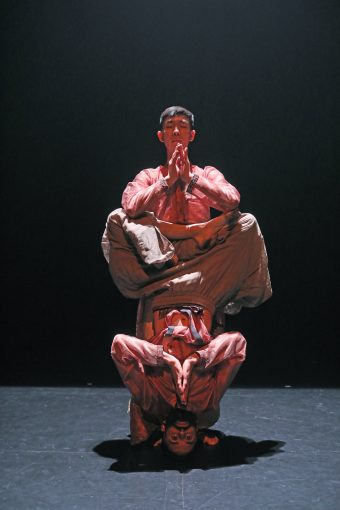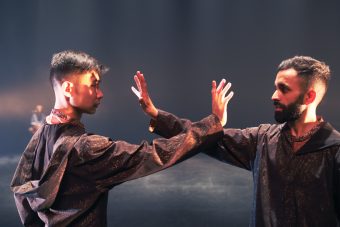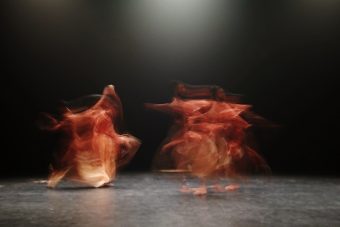samsara
noun
the cycle of death and rebirth to which life in the material world is bound
Origin
SANSKRIT
The performance of Samsara at the Playhouse Theatre at Arts Centre Melbourne was met with a standing ovation. It was a crowd that spanned ethnicity and age, seemingly disparate but bound in awe and by the journey the performance evoked.
As part of Asia TOPA 2020, Melbourne was privileged to host the world premiere of the transnational dance production Samsara (March 5–7), an intercultural mingling of Indian and Chinese art forms in a timeless journey narrative.

The word samsara is intrinsically bound to Buddhism, Hinduism and karmic understandings of life. Among many things it encompasses cycles, world, wandering. My Mumbai born-and-raised father tells me it must mean ‘speak’. In his mother tongue Malayalam, a southern Indian language derived from Sanskrit, samsaram means ‘to speak’. Speaking, in a way, is a kind of cycle: a back and forth between people, a wandering with words to find meaning, a journey of expression and understanding. The duet dancers in Samsara, Aakash Odedra (UK/India) and Hu Shenyuan (China) do not share a mutual language but they speak and understand one another in movement. Their deep respect for each other’s dance forms, abilities, religious practices and respective cultural histories can be seen in their seamless collaboration. Arts Centre Melbourne quoted Odedra in a comment he made about their connection:
“When I met Hu there was an instant connection. We were two bodies but one soul. It feels like I’ve known him before; I can’t explain it. We dance very differently but it’s also similar too. As soon as we’re together our energies become yin and yang; we become one. There’s this unspoken way of working which has allowed us to exchange on a cultural level.”
The duo progressed through many stages—they moved first in discord, then battle, in unison, as one entity, in worship, as a mirror and as a shadow of each other. It was a performance capturing a full range of emotions and relationships a person can have with another, or oneself. Journey stories are not only about the physical plight and the end result, but the inner battle and journey of self-discovery.
Their dynamic performance was an adaptation of a classic Chinese novel, Journey to the West (Wu Cheng’en, 16th century). The novel is based on a legendary monk’s arduous quest to western Asia to obtain Buddhist scripture. Deeply rooted in Chinese mythology and folklore, the story has been repeatedly adapted in a range of forms; most recently and famously in the Korean drama, The Korean Odyssey.

To reflect mythology and legend, one of the main dance forms used was Kathak. Kathak has a long history in India as a story telling medium, often in service of epics or mythology. Odedra is highly trained in both Kathak and Bharatanatyam, two of the eight forms of Indian classical dance. Kathak is a high energy dance that relies on extensive footwork and has significant Muslim influence, notably sufi hand movements. The choreography of Samsara blended dance forms from Chinese traditions and Kathak, while also drawing on contemporary and ballet disciplines to create a performance of exquisite balance, contrast, dissonance and unification.
Similarly, the music was an experimental blend, which paid homage to Indian and Chinese traditions while also incorporating modern western elements. Singer-composer Nicki Wells (UK) commanded a huge vocal range, complementing Michael Ormiston’s Mongolian Khoomi (overtone) singing. Combined with a number of instruments played by Ormiston, and Beibei Wang’s electrifying percussion, the music was a performance of its own.

The minimalist set design afforded space and attention to the dancers as well as the musicians, who performed behind a screen that phased in and out of transparency. Hu and Odedra shared the stage with small humanesque statues that suggested a sense of searching, past pilgrimage, spirituality. They were joined at one point by sand that cascaded from above. The sand embodied many roles in powerful moments throughout the piece – it was an object to exchange between them, something to dance with and a material to forge a golden path on stage. Odedra performed a sequence where he spun beneath falling sand for what seemed like an impossible length of time. It was a demonstration of his strength which highlighted for me how dependent a journey is on endurance. His movements also were poised and graceful, complemented by how the spotlight imbued the sand in a golden shine.
The story was evoked through the sharp use of light and shadow, and the way the physical performance mirrored the music. It began and ended with the solitary, poised figure of Hu Shenyuan under a single spotlight. He moved like flowing water in slow motion—languid, writhing movements, his control and flexibility exemplified. In sharp contrast, a following sequence portrayed two enemies in high-energy battle, throwing blows in time to drumbeats in a perfectly choreographed fight. Throughout Samsara, the music, the set and the two star dancers came together as one powerful storytelling entity.

Transnational collaborations like Samsara (supported and produced by partners in China, UK, France and Australia) may have economic benefits for the countries involved and may deepen political ties, but they also give way to intercultural communication. The opportunity for different countries and communities to work together can allow them to learn from each other and expand their industries. It can also deepen mutual understandings of the arts, history and culture of other countries. Samsara demonstrates that while culture can distinguish and language can be a barrier, talent and stories can still transcend boundaries.


Very well written Monique. By the way “Samsara” also means in Sanskrit the birth and death cycle in which we human beings are entangled because of our false identification with our body, mind and intellect. The goal of a human being is to discover his self..the pure consciousness. So the Vedic scriptures shows us the way to liberate ourselves from this “Samsara”.
Kudos to you Monique